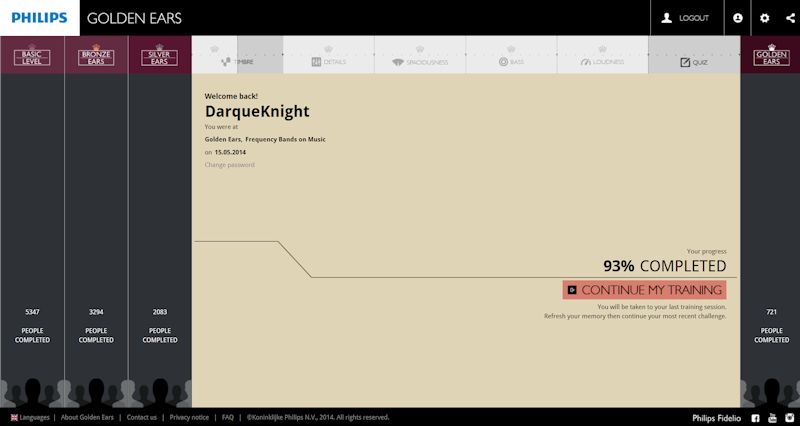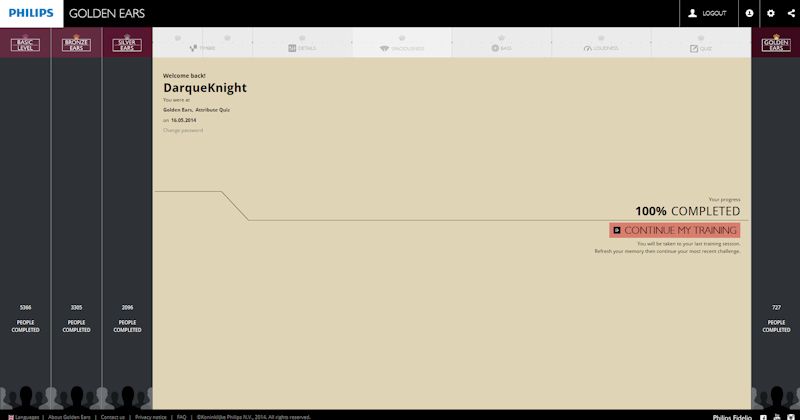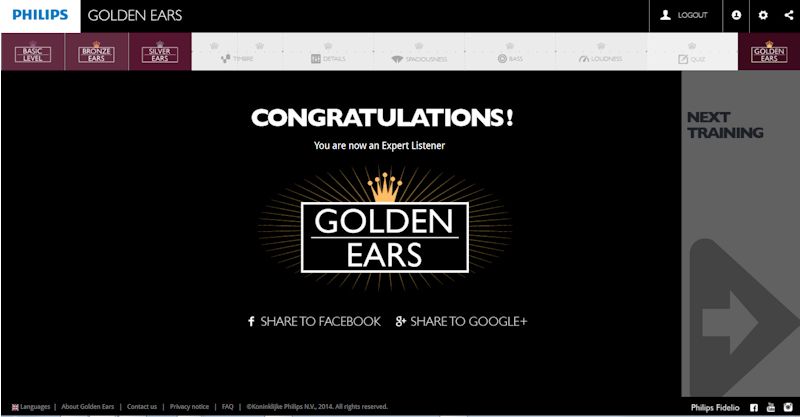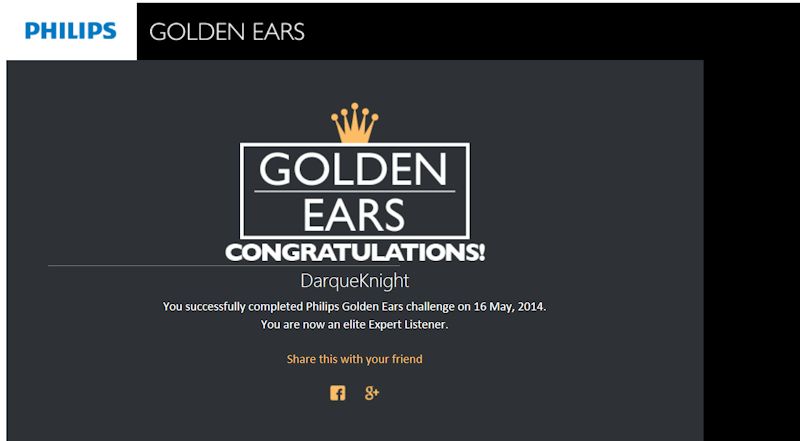Philips' Golden Ears Challenge

DarqueKnight
Posts: 6,765
Introduction
I recently completed Philips' Golden Ears Challenge at https://www.goldenears.philips.com/en/introduction.html. This description of the test is taken from the Golden Ears website:
"Our unique Golden Ears training program was designed to develop the listening skills of our audio engineers. Their listening expertise ensures we create products of superior sound quality that highlight every musical detail.
Graduates of the Golden Ears program can reliably detect subtle differences in sound based on the following five key attributes.
1. Timbre - Differences in tone or the frequency of content of music.
2. Details - The lack of treble, distortion, or noise that can mask the fine details.
3. Spatial Impression - The depth and spaciousness of the soundfield.
4. Bass - The quality of low frequencies.
5. Loudness - The perception of sound power, from quiet to loud."
My Golden Ears Test Experience
The test is designed to be taken with headphones. For some tests, such as spatial impression and timbre, I would use the computer's loudspeakers. I am not a regular user of headphones. The equipment used was:
Polk Audio UltraFocus 8000 headphones.
Creative SoundBlaster X-Fi Titanium sound card.
Polk Audio SurroundBar IHT speakers.
Dell XPS 9000 desktop computer.
You are allowed to take as much time as you need to complete test exercises. You can also log out and later resume testing where you left off. Prior to each test section, there are ear training exercises. You can stop in the middle of a test and go back for retraining, then resume the test where you left off. The test progresses through four levels of increasing difficulty. The most difficult parts of the exam required some study and practice. On particularly complex sound samples, I would catalog and describe all the sound components in writing. That made it much easier to discern differences.
I completed 93% of the test, comprising the first three levels (Basic, Bronze, and Silver ears), plus over 60% of the Golden ear level in 2.5 hours: 1/2 hour each for the Basic and Bronze levels and 45 minutes for the Silver level and 45 minutes for four sections of the Gold level. I completed the remaining two sections of the Gold level tests in 2 hours the next day. An hour and fifteen minutes of the second day was spent in study and 45 minutes in test taking, for a total of 4.5 hours.

The first day's progress.

Finished on the second day.

After completion of the Golden Ears level, this congratulatory message was displayed.

Upon completion of the Golden Ears level, a certificate with your account name is emailed to you.
I was the 728th person to complete the Golden Ears level. At the time I completed the test:
5366 people had completed the Basic Ear level.
3305 people had completed the Bronze Ear level.
2096 people had completed the Silver Ear level.
727 people had completed the Golden Ear level.
I recently completed Philips' Golden Ears Challenge at https://www.goldenears.philips.com/en/introduction.html. This description of the test is taken from the Golden Ears website:
"Our unique Golden Ears training program was designed to develop the listening skills of our audio engineers. Their listening expertise ensures we create products of superior sound quality that highlight every musical detail.
Graduates of the Golden Ears program can reliably detect subtle differences in sound based on the following five key attributes.
1. Timbre - Differences in tone or the frequency of content of music.
2. Details - The lack of treble, distortion, or noise that can mask the fine details.
3. Spatial Impression - The depth and spaciousness of the soundfield.
4. Bass - The quality of low frequencies.
5. Loudness - The perception of sound power, from quiet to loud."
My Golden Ears Test Experience
The test is designed to be taken with headphones. For some tests, such as spatial impression and timbre, I would use the computer's loudspeakers. I am not a regular user of headphones. The equipment used was:
Polk Audio UltraFocus 8000 headphones.
Creative SoundBlaster X-Fi Titanium sound card.
Polk Audio SurroundBar IHT speakers.
Dell XPS 9000 desktop computer.
You are allowed to take as much time as you need to complete test exercises. You can also log out and later resume testing where you left off. Prior to each test section, there are ear training exercises. You can stop in the middle of a test and go back for retraining, then resume the test where you left off. The test progresses through four levels of increasing difficulty. The most difficult parts of the exam required some study and practice. On particularly complex sound samples, I would catalog and describe all the sound components in writing. That made it much easier to discern differences.
I completed 93% of the test, comprising the first three levels (Basic, Bronze, and Silver ears), plus over 60% of the Golden ear level in 2.5 hours: 1/2 hour each for the Basic and Bronze levels and 45 minutes for the Silver level and 45 minutes for four sections of the Gold level. I completed the remaining two sections of the Gold level tests in 2 hours the next day. An hour and fifteen minutes of the second day was spent in study and 45 minutes in test taking, for a total of 4.5 hours.

The first day's progress.

Finished on the second day.

After completion of the Golden Ears level, this congratulatory message was displayed.

Upon completion of the Golden Ears level, a certificate with your account name is emailed to you.
I was the 728th person to complete the Golden Ears level. At the time I completed the test:
5366 people had completed the Basic Ear level.
3305 people had completed the Bronze Ear level.
2096 people had completed the Silver Ear level.
727 people had completed the Golden Ear level.
Proud and loyal citizen of the Digital Domain and Solid State Country!
Post edited by DarqueKnight on
Comments
-
Very nice write up as always DK. Assimilated has mentioned this in another thread as well. This is something I might be able to get around to this summer, but we'll just have to see...Living Room 2.2: Usher BE-718 "tiny dancers"; Dual DIY Dayton audio RSS210HF-4 Subs with Dayton SPA-250 amps; Arcam SA30; Musical Fidelity A308; Sony UBP-x1000es
Game Room 5.1.4: Denon AVR-X4200w; Sony UBP-x700; Definitive Technology Power Monitor 900 mains, CLR-3000 center, StudioMonitor 350 surrounds, ProMonitor 800 atmos x4; Sub - Monoprice Monolith 15in THX Ultra
Bedroom 2.1 Harmon Kardon HK3490; Bluesounds Node N130; Polk RT25i; ACI Titan Subwoofer -
I did not become aware of Assimilated's thread until I saw it listed in the "Similar Threads" section at the bottom of the page. I took the test after it was mentioned by Habanero Monk in another thread.Proud and loyal citizen of the Digital Domain and Solid State Country!
-
I didn't get the completion email, but took a screenshot when I completed the test, I think it took me a little under two hours.
-
I made it to silver and got bored. so I put on a blindfold.....and failed it badly:sad:
I did enjoy it, and was thinking about it while some heated discussion's were going on in that other cable thread...I don't consider myself a trained listener by any means but did ace most of it up to the silver ears stuff and then like I said got bored.



